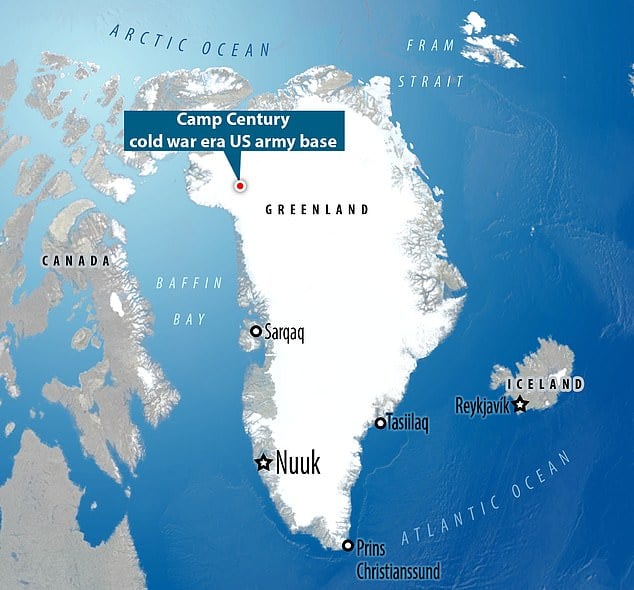It’s all about cycles! Most of Greenland is covered with ice today. But a new study shows that within the last million years it melted off and became covered with green tundra.

In 1966, US Army scientists drilled down through nearly a mile of ice in northwestern Greenland and pulled up a fifteen-foot-long tube of dirt from the bottom. Then this frozen sediment was lost in a freezer for decades. It was accidentally rediscovered in 2017.
In 2019, University of Vermont scientist Andrew Christ looked at it through his microscope and couldn’t believe what he was seeing: twigs and leaves instead of just sand and rock.
That suggested that the ice was gone in the recent geologic past and that a vegetated landscape, perhaps a boreal forest, stood where a mile-deep ice sheet as big as Alaska stands today.
Greenland ice FREE
After a year of careful investigations, Christ and his fellow scientists showed that most, or all, of Greenland must have been ice-free within the last million years, perhaps even the last few hundred-thousand years.
“Ice sheets typically pulverize and destroy everything in their path,” says Christ, “but what we discovered was delicate plant structures—perfectly preserved. They’re fossils, but they look like they died yesterday. It’s a time capsule of what used to live on Greenland that we wouldn’t be able to find anywhere else.”
The discovery helps confirm a new and troubling understanding that the Greenland ice has melted off entirely during recent warm periods in Earth’s history. IT’S ALL ABOUT CYCLES!
Cold war military base
The material for the new PNAS study came from Camp Century, a Cold War military base dug inside the ice sheet far above the Arctic Circle in the 1960s. The real purpose of the camp was a super-secret effort, called Project Iceworm, to hide 600 nuclear missiles under the ice close to the Soviet Union. As cover, the Army presented the camp as a polar science station.
And I guess many countries are now doing the same in Antarctica.
4560-foot-deep ice core
The military mission failed, but the science team did complete important research, including drilling a 4560-foot-deep ice core. The Camp Century scientists were focused on the ice itself. They, apparently, took less interest in a bit of dirt gathered from beneath the ice core.
Then, in a truly cinematic set of strange plot twists, the ice core was moved from an Army freezer to the University of Buffalo in the 1970s, to another freezer in Copenhagen, Denmark, in the 1990s, where it languished for decades until it surfaced when the cores were being moved to a new freezer.
New results
The new study makes clear that the deep ice at Camp Century, some 75 miles inland from the coast and only 800 miles from the North Pole, entirely melted at least once within the last million years and was covered with vegetation, including moss and perhaps trees.
Radiocarbon-dating of bits of wood in the ice and analysis of how layers of ice and debris were arranged allowed the team to be clear that most, if not all, of Greenland melted at least once during the past million years, making Greenland green with moss and lichen, and perhaps with spruce and fir trees.
And the new study shows that ecosystems of the past were not scoured into oblivion by ages of glaciers and ice sheets bulldozing overtop. Instead, the story of these living landscapes remains captured under the relatively young ice that formed on top of the ground, frozen in place, and holds them still.
The new research lines up with data from two other ice cores from the center of Greenland, collected in 1990s. Sediment from the bottom of these cores also indicate that the ice sheet was gone for some time in the recent geologic past.
“Greenland may seem far away,” says UVM’s Paul Bierman, “but it can quickly melt, pouring enough into the oceans that New York, Miami, or pick up your city, will go underwater.”
A bit like Antarctica and its volcanoes, don’t you think?
Now subscribe to this blog to get more amazing news curated just for you right in your inbox on a daily basis (here an example of our new newsletter).
You can also follow us on Facebook and/ or Twitter. And, by the way you can also make a donation through Paypal. Thank you!












Factor in The Flood, and it is no mystery at all.
Wait. What’s the name of that island? GREENLAND!!!!! Obviously it was named in the past few hundred years and wasn’t named Snowland or such but Greenland. My bet it was green when founded.
https://wattsupwiththat.com/2019/02/07/study-shows-that-vikings-enjoyed-a-warmer-greenland/
That video is ‘global warming’ crap but the article is great.